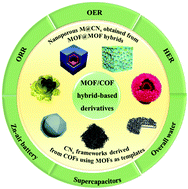Process of metal–organic framework (MOF)/covalent–organic framework (COF) hybrids-based derivatives and their applications on energy transfer and storage
Abstract
The fossil-fuel shortage and severe environmental issues have posed ever-increasing demands on clean and renewable energy sources, for which the exploration of electrocatalysts has been a big challenge toward energy transfer and storage. Some indispensable features of electrocatalysts, such as large surface area, controlled structure, high porosity, and effective functionalization, have been proved to be critical for the improvement of electrocatalytic activities. Recently, the rapid expansion of metal–organic frameworks (MOFs), covalent–organic frameworks (COFs), and porous-organic polymers has provided extensive opportunities for the development of various electrocatalysts. Moreover, combining diverse descriptions of porous–organic frameworks (such as MOFs and COFs) can generate amazing and fantastic properties, affording the formed MOF/COF (including core–shell MOF@MOF and MOF@COF and layer-on-layer MOF-on-MOF or COF-on-MOF) heterostructures wide applications in diverse fields, especially in clean energy and energy transfer. To further boosts electronic conductivity, catalytic performances, and energy storage abilities, these MOF/COF hybrid materials have been widely utilized as versatile precursors for the manufacture of transition metal catalysts embedded within mesoporous carbon nitrides (M@CNx) and porous carbon nitride frameworks (CNx) via a facile pyrolysis process. Given that these M@CNx and CNx hybrids are composed of abundant catalytic centers, rich functionalities, and large specific surface areas, vast applications in energy transfer and energy storage fields can be realized. In this mini-review, we summarize the preparation strategies of MOF/COF-based hybrids, as well as their derivatives, nanostructure formation mechanism of M@CNx and CNx hybrids from MOF/COF-based hybrid materials, and their applications as catalysts for driving diverse reactions and electrode materials for energy storage. Further, current challenges and future prospects of applying these derivatives into energy conversion and storage devices are also discussed.

- This article is part of the themed collections: Recent Review Articles and Editor’s Choice: Functional MOFs and COFs


 Please wait while we load your content...
Please wait while we load your content...